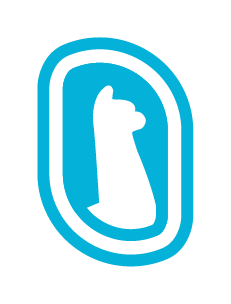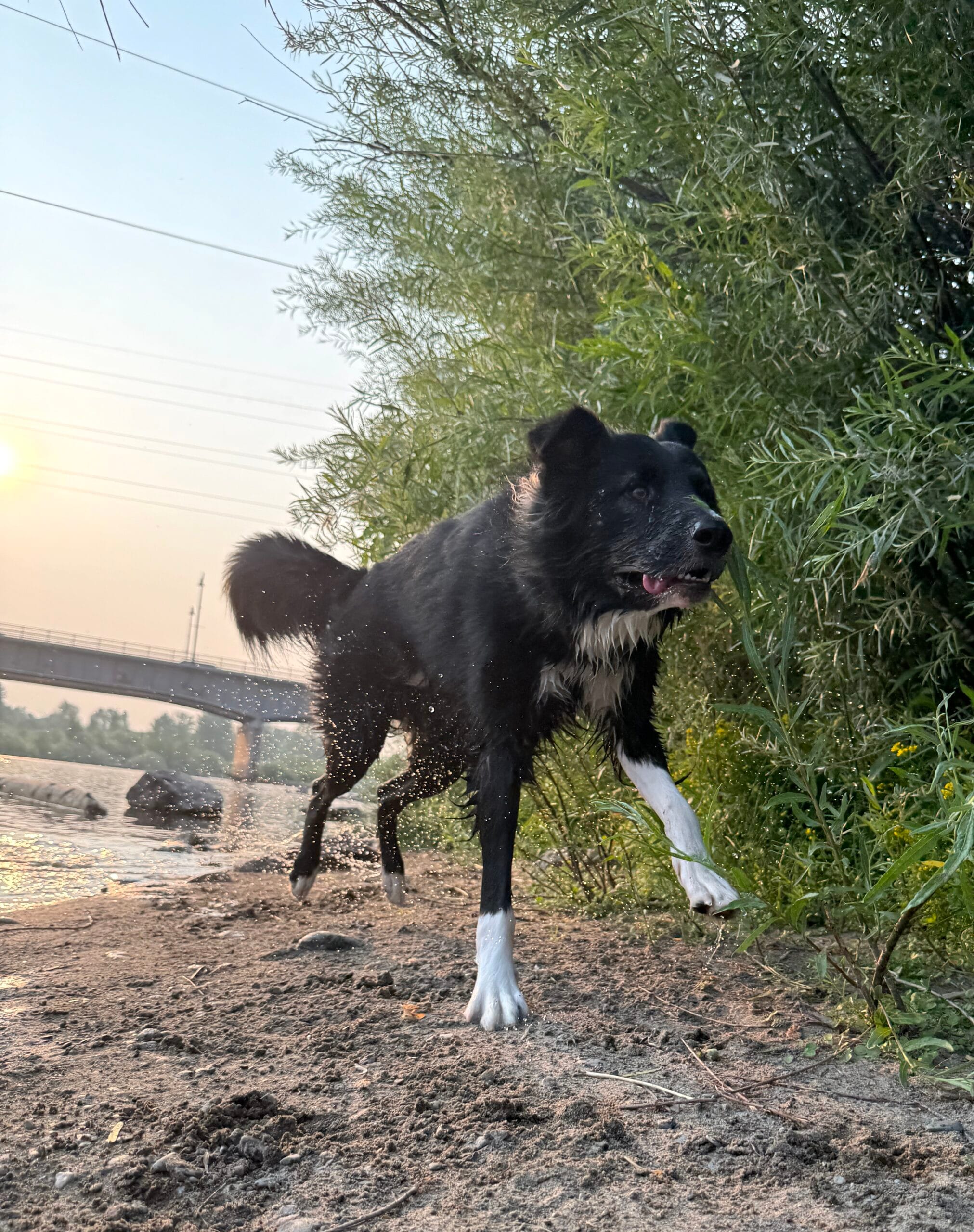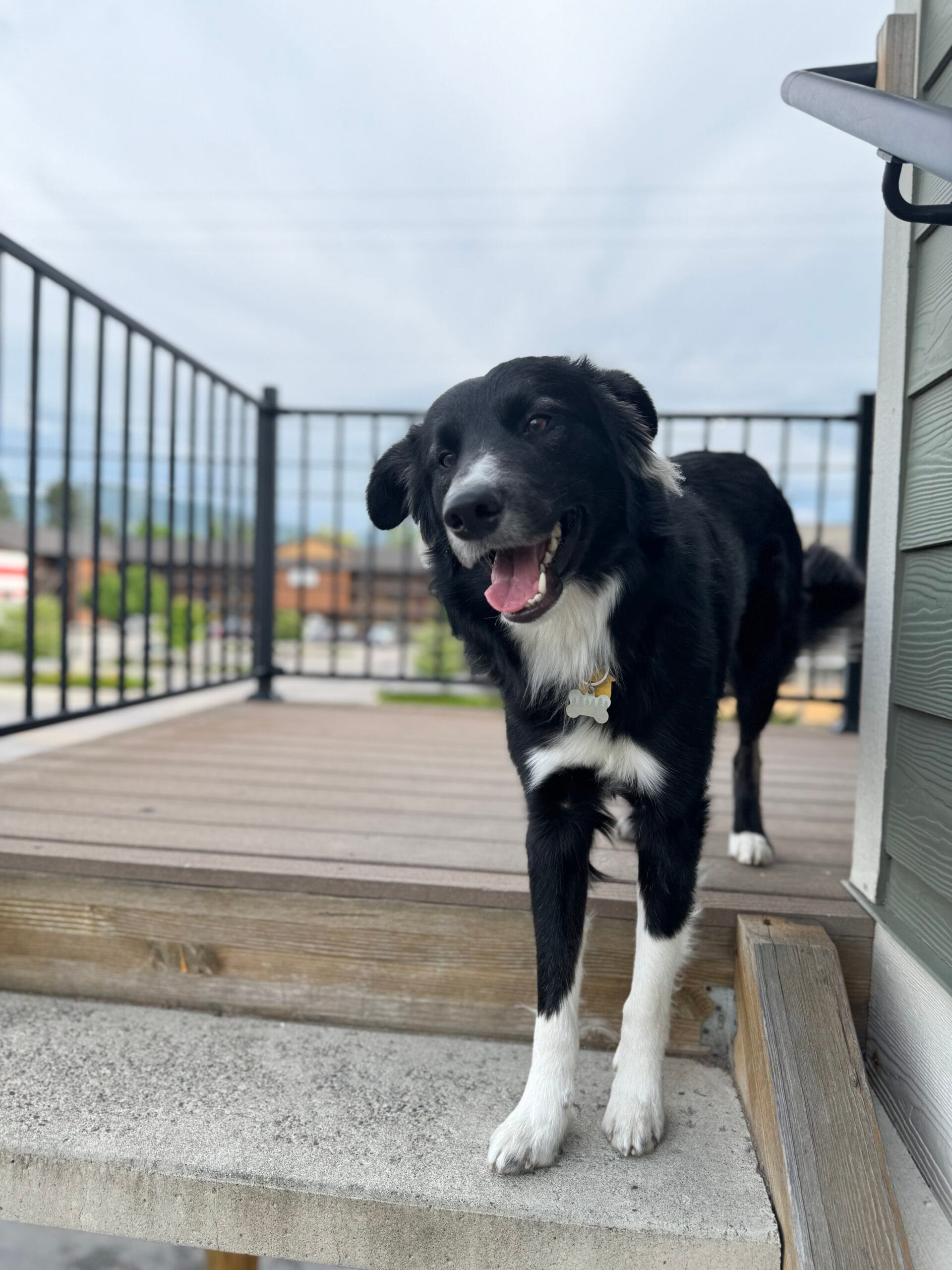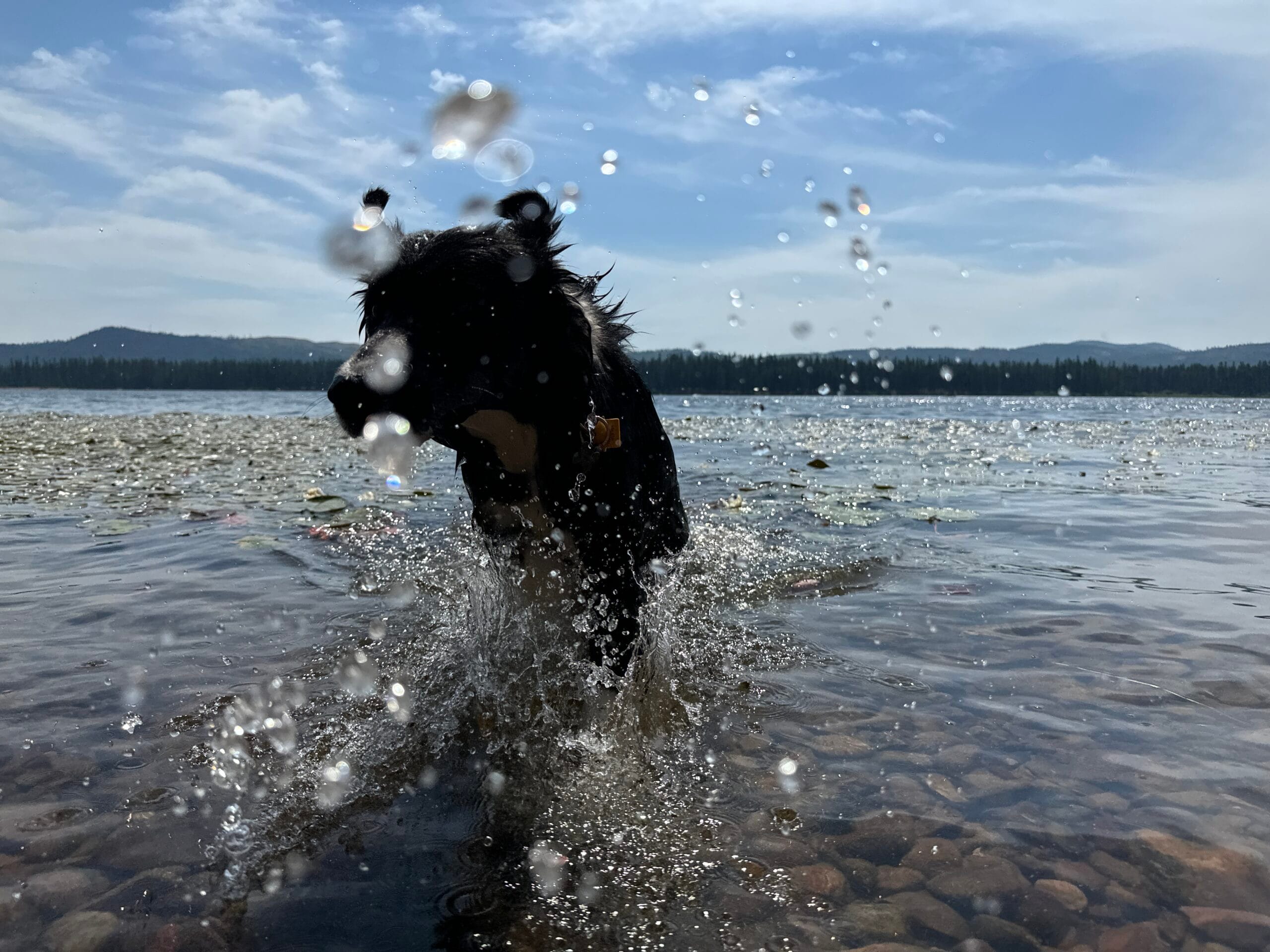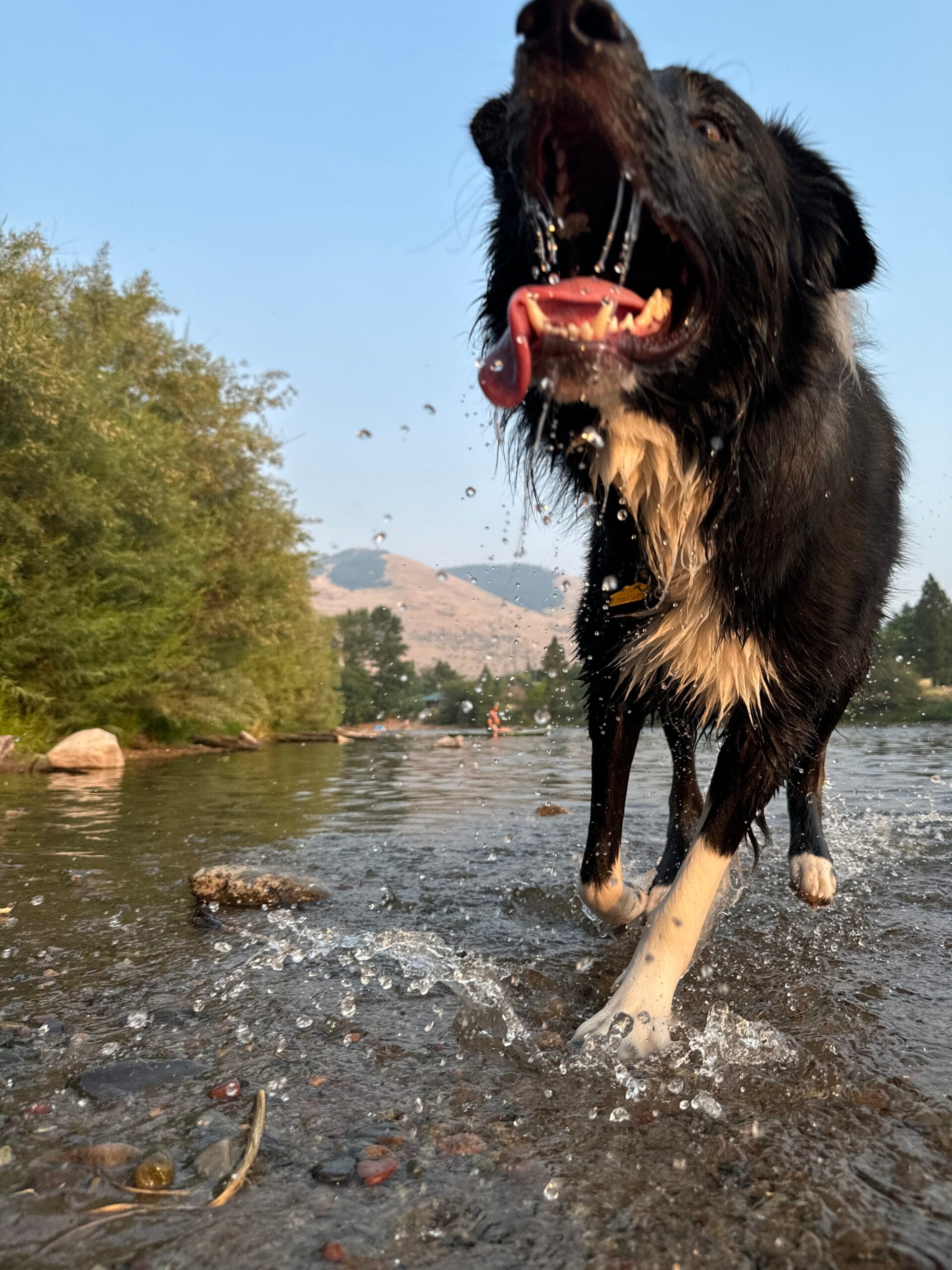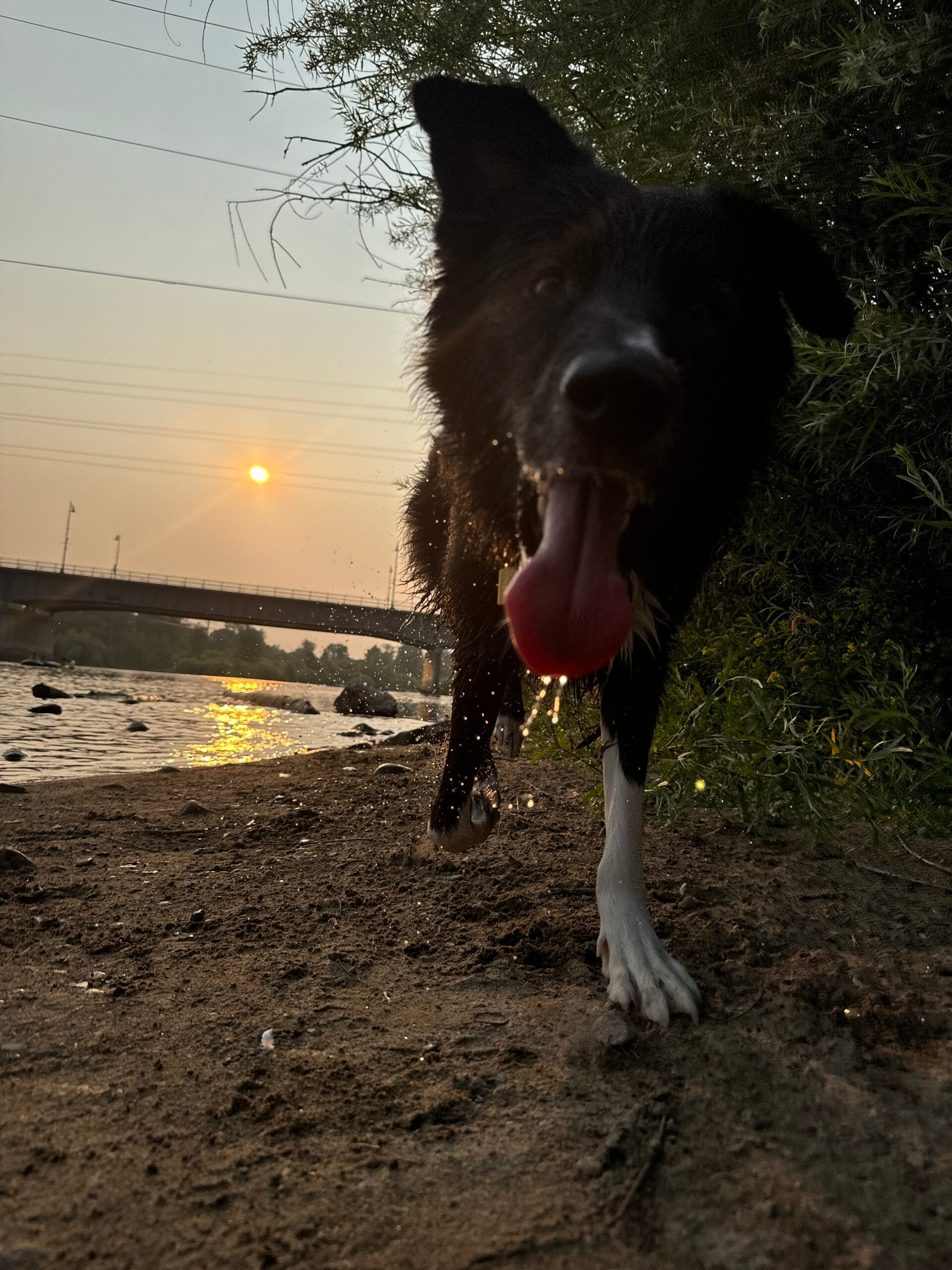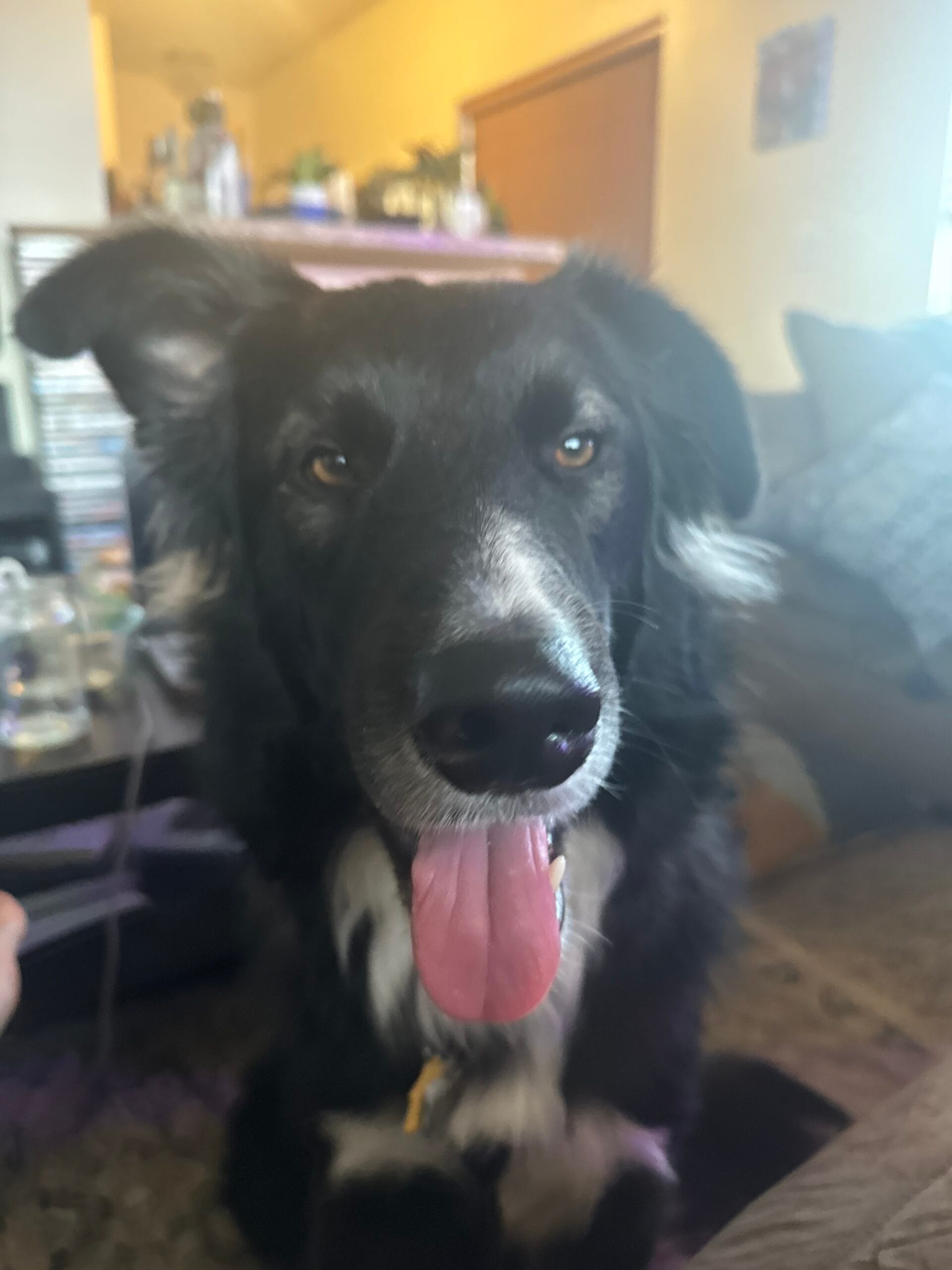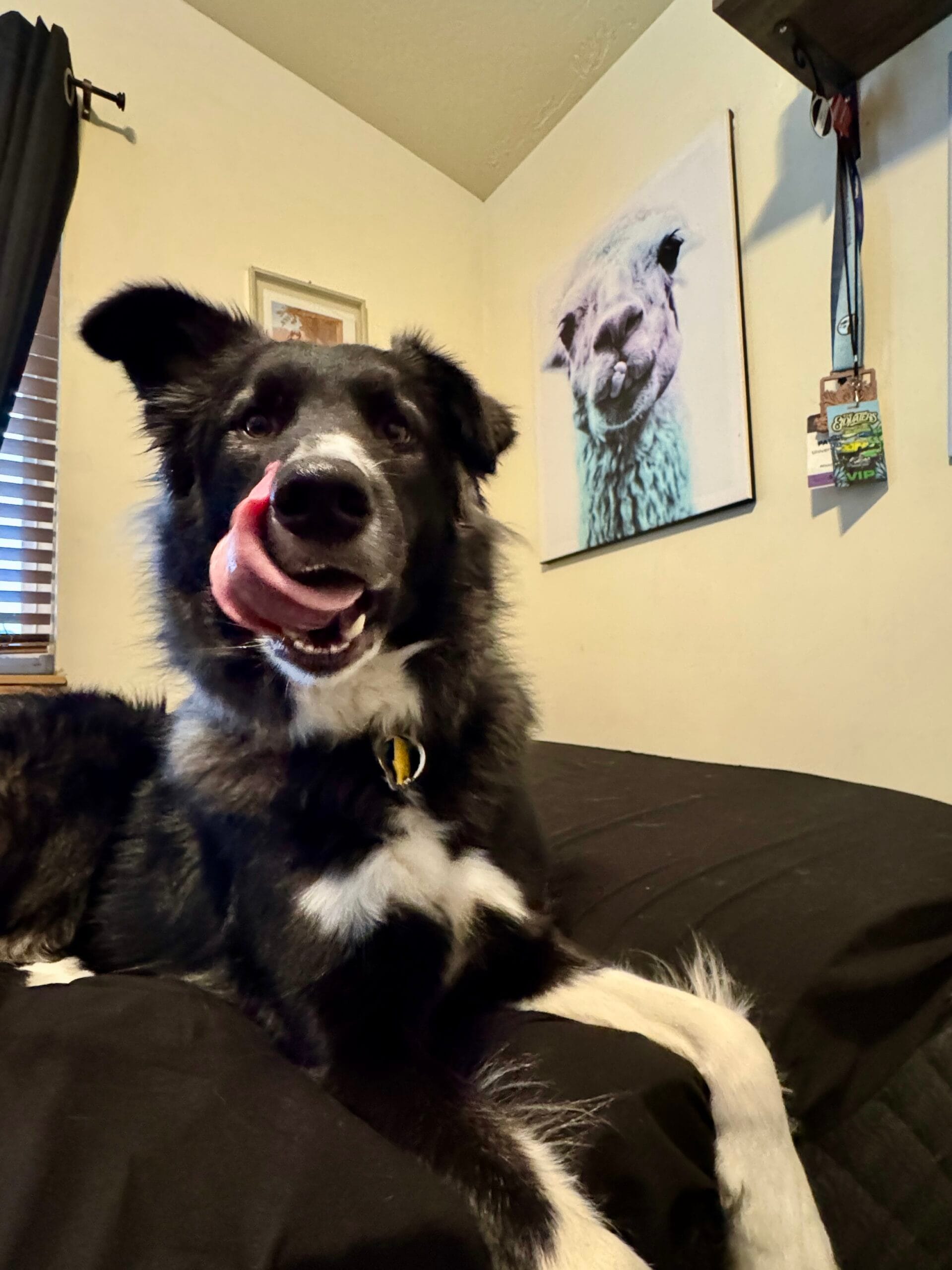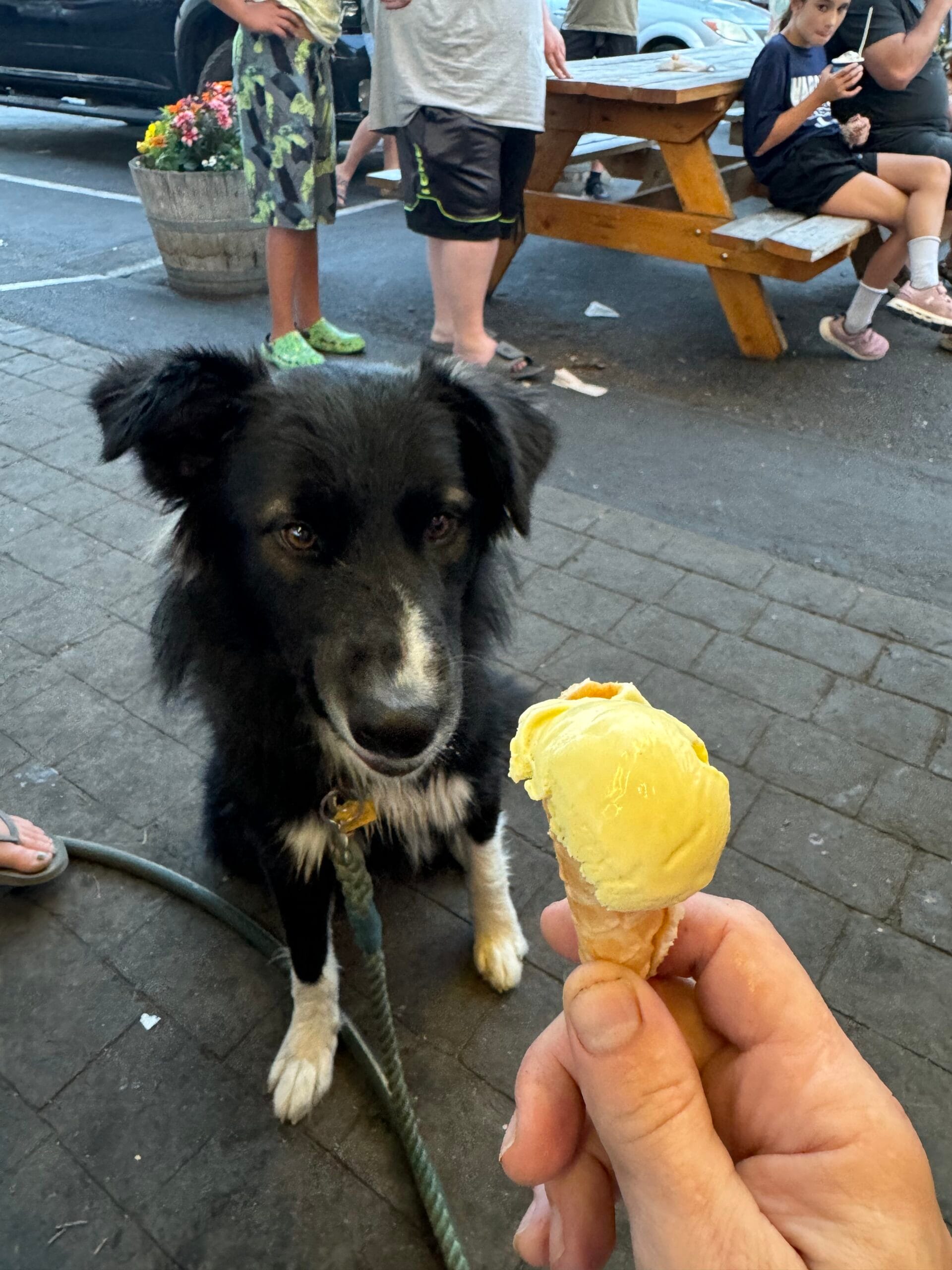“Dogs possess a quality that’s rare among humans—the ability to make you feel valued just by being you…”
— Caroline Knapp
What Missoula’s Dogs Say About Our Psyche, Our Chains, and Our Connection
Walk a dog through Missoula, and you’ll witness the most reliably redemptive public ritual we have: complete strangers becoming human again. People who were seconds away from giving you the cold shoulder will soften, smile, and even stop. They’ll crouch down mid-sidewalk and speak in a voice reserved for infants and sacred animals.
Not to you, of course. To the dog.
“What’s her name?”
“How old is he?”
“Oh my gosh. Who’s a good boy?!”
This isn’t just a Missoula thing, but Missoula has made it a local art form. Our love for dogs is beautiful. It’s also a little revealing. And like most things humans can overdo, it holds a mirror to something underneath.

Let’s be clear: this isn’t an anti-dog piece. I love animals and especially my dog, Senko. He’s half husky, a quarter poodle, and a quarter collie. He’s got this mix of soulful eyes and chaotic joy that makes him impossible not to love. I’ve shared him on social media not because I’m trying to be cute, but because of how he increases engagement—it’s easier it is for people to connect with Stigma M&D when he’s in the frame. Just like on the street.
P.S. You can see more of Senko—the half-chaos, full-heart sidekick—at the end of this post. He’s got a gallery down there.
Senko and I once did a shoot with Toiffer, the local premium dog supply folks. They run this great collab model where they shoot with local pets and donate proceeds to nonprofits. It’s authentic local marketing—real collaboration, no fake influencer stuff. He’s also a huge fan of White Trash Beach down at the river—he’ll run loops from the water to the trees and back like he’s chasing his own joy. But don’t ask him to take the metal stairs down from the Higgins Bridge into Caras Park. Those see-through steps scare the crap out of him. We all have our growth areas, I guess.
And while Missoulians love dogs, they seem increasingly less favorable toward people. I’ve had drivers nearly hit me in a crosswalk downtown—angry, impatient—only to slam on the brakes and apologize once they saw Senko. That’s not broken. It’s revealing.
Lipstick, Dogs, and the Marketing Lie
Let’s talk about how this shows up in marketing, since the same mechanism that makes us assign purity and goodness to dogs is the one that gets hijacked by inauthentic branding and campaigns. It’s the same reason a brand can slap a label on their logo and still treat their employees like numbers. It’s why we say things like “lipstick on a pig” — because we know when something’s being dressed up to look like something else.
Marketing is full of projection. We project our best selves into the brand. Stereotypical marketing plays on that—it tries to convince people they’re missing something essential, and then sells itself as the answer. It plays on emotion, credibility, and logic—“this will make you feel better,” “everyone’s doing it,” “you aren’t good enough yet”—it does it with gimmicks, near-truths, and polish instead of real substance. We mask our disconnection with storytelling. We enhance our image until it reflects what we wish were true. But good marketing—authentic marketing—starts the other way around. It starts with something real: a business that gives a damn, a team that serves in its mess, a story that doesn’t skip the struggle.
More than 80% of consumers say they need to trust a brand before buying from it. The number jumps even higher for Gen Z and Millennials. And it’s not just trust—they’re looking for consistency, transparency, and relational depth. In a post-AI world, where SEO can simulate sincerity and ChatGPT can mimic tone, what stands out isn’t language polish—it’s lived truth.

Here are more statistics to consider:
- 87% of consumers will pay more for products from brands they trust (acr-journal.com).
- 94% of consumers are more loyal to a brand committed to full transparency (acr-journal.com).
- 86% of Americans believe business transparency is more important than ever (Sprout Social).
- 79% of B2C leaders believe consumers trust their brand—but only 52% of actual consumers feel the same (cdp.com).
- 75% of consumers say transparency is important in brand engagement (seths.blog).
- 93% of Americans reported doing a small act of kindness in the past 3 months—like saying hello to a stranger or holding a door (psychiatry.org).
When companies try to automate empathy or outsource voice, people notice. We don’t need more messaging—we need more modeling. Modeling that starts with real humans, owning real stories, and showing up with real care. When businesses practice this kind of integrity, marketing becomes less about conversion and more about connection. Less about controlling perception, more about embodying presence.
The projection trap isn’t just bad psychology—it’s bad business. It teaches us to overcomplicate our marketing, fear honesty, and perform intimacy instead of practicing it. But when we stop pretending and start relating, everything shifts. We build resonance, not just reach. We earn attention because we give it. We build brands people trust because they see themselves—not our projections—reflected in them.
So maybe marketing—real marketing—isn’t about messaging. Maybe it’s about modeling. Modeling the kind of clarity, kindness, truth, and transparency that makes people feel safe to be human again.
Dogs as Projected Innocence
Carl Jung wrote that we don’t see the world as it is—we see it as we are. What we fail to consciously own within ourselves, we unconsciously project onto others. Most of the time, we notice this in negative terms: we accuse others of being what we can’t admit in ourselves. But projection also works in reverse. We project our innocence, our hope, our yearning for love and simplicity onto others, too. And our dogs receive a lot of it.

Dogs have become the projection screens for the parts of ourselves we’ve lost touch with. We assign them language and roles we can no longer comfortably offer humans. We say they’re our “babies,” that they “rescued us,” that they’re “better than people.” We throw them parties, buy them supplements, sleep with them in our beds, and prioritize their healthcare over our own.
And while a lot of that is endearing and good, it also reveals a shift: we are substituting human relationships with symbolic ones. We are replacing risky, reciprocal connections with safe, one-sided attachments. Dogs love us no matter what. They don’t critique. They don’t contradict. They don’t require emotional maturity. They just show up. Which is comforting. And also, revealing.
“The most dangerous psychological mistake is the projection of the shadow on to others; this is the root of almost all conflicts.”
— Carl Jung
Language Has Consequences
When we call ourselves “pet parents,” we’re not just being cute. That language starts to reshape our internal models of relationship, responsibility, and love—sometimes substituting one kind for another. It might feel harmless, but we’re practicing a way of seeing ourselves and others. And once that language takes root, it doesn’t stay still—it gets passed down, reinforced, and evolves on its own.
Neither is this a rant against affection or attachment. Pets are good. Real. Healing. But if we find it easier to know our dog’s groomer than our next-door neighbor, that’s worth sitting with. Like everything human, it can get out of hand—slide out of balance. If we’re more likely to open a door for someone walking a Goldendoodle than someone juggling groceries, that might be saying something. If we instinctively ask for the dog’s name but never think to ask the person holding the leash, maybe we’ve lost something basic about being human.
From Projection to Practice
“Pets are humanizing. They remind us we have an obligation and responsibility to preserve and nurture and care for all life.”
— James Cromwell
So, here’s the rub: what we project, we neglect. What we neglect, we try to replace. And what we neglect long enough, we eventually forget how to do. It’s a human thing. If all our humanity goes to our pets, we forget how to offer it to people. If all our patience is reserved for animals, we lose it faster with our kids. If our dogs are our only source of physical touch, presence, or routine, we start to fear—or avoid—those same needs in human relationships.
None of this makes dogs bad, or us for loving them. It just makes them emotional amplifiers. They create space for joy, for shared moments, for not taking ourselves so seriously. They remind us we’re not alone. They hold space for the parts of us we haven’t practiced elsewhere.
But what if we did practice?
What if every time you greeted a dog, you also asked their human their name? What if you offered the same softness you give your golden retriever to the barista who’s been on her feet for six hours? What if you looked up and smiled before your dog gave you a reason to?
Love Your Neighbor (Not Just Their Dog)
When I moved to Missoula over seven years ago, I had the opportunity to interview then-Mayor John Engen as part of a demographic research project and report we were putting together. He talked about how generosity and humanity were core values of Missoula—you can still see it in the culture of nonprofits, the number of charitable events, and the way neighbors showed up for each other.
And yet, in the years since—through COVID, economic shifts, and the city’s rapid change—something’s gotten shakier. I’ve heard it from plenty of locals, old and new. The Missoula of today feels like it’s lost some of that spark. The warmth is still there, but thinner. Trust is more guarded. Belief in each other feels more conditional. And honestly? Who can blame us? There’s a lot going on in the world.
Still, I believe Missoula has everything it needs to come home to itself again.

Our love for dogs is a gift. They slow us down. They make us approachable. They open relational doors. But they shouldn’t be our only ones. The people around us are carrying just as much good, struggles, and meaning as we are. They’re just harder to read. They don’t have wagging tails, but they have names and stories.
So, let’s use the gift. Let’s let our dogs be the relational bridge they are—but let’s not stop there. Say hi to the stranger. Ask the clerk how her day is going. Offer to jump someone’s car. Look people in the eye. Learn your neighbors’ names. Not out of moral obligation, but because these small, daily acts of attention are what weave us back together.
Love isn’t just a sentiment. It’s a practiced posture. One that has to move beyond dogs and start extending back to people, even the complicated ones. Even the quiet ones. Even the ones who don’t smile back right away.
After all, you never know who’s secretly hoping someone will treat them like they treat their dog.
Keep calm and love thy neighbor.
“Projection is one of the commonest psychic phenomena…Everything that is unconscious in ourselves we discover in our neighbour, and we treat him accordingly.”
— Carl Jung
🐾 Meet Senko
Part husky, part poodle-collie, all heart.
This is the dog who’s taught me more about presence, patience, and projection than most humans. He’s also a marketing assistant—turns out he opens hearts on the street and boosts engagement online. If you ever see him with me, he loves all the attention he can get.


















